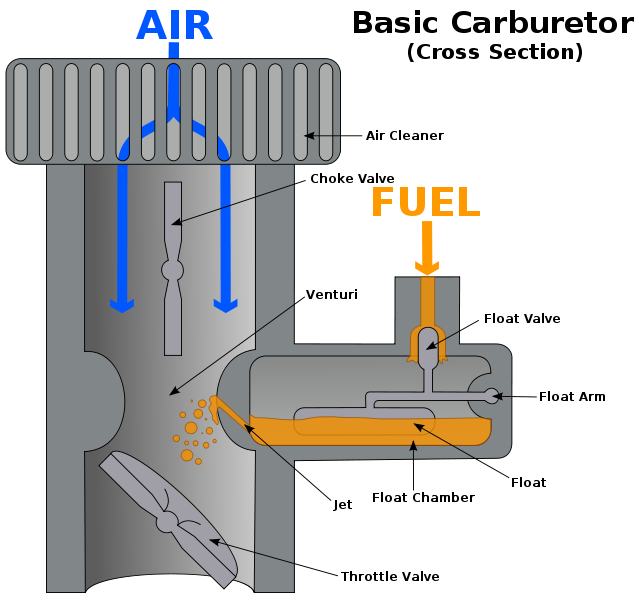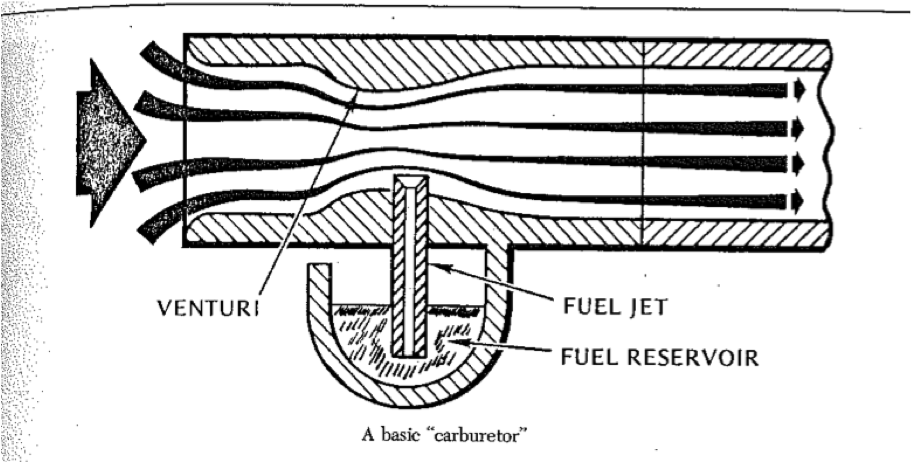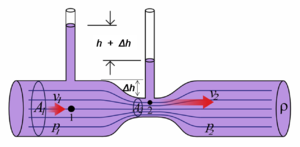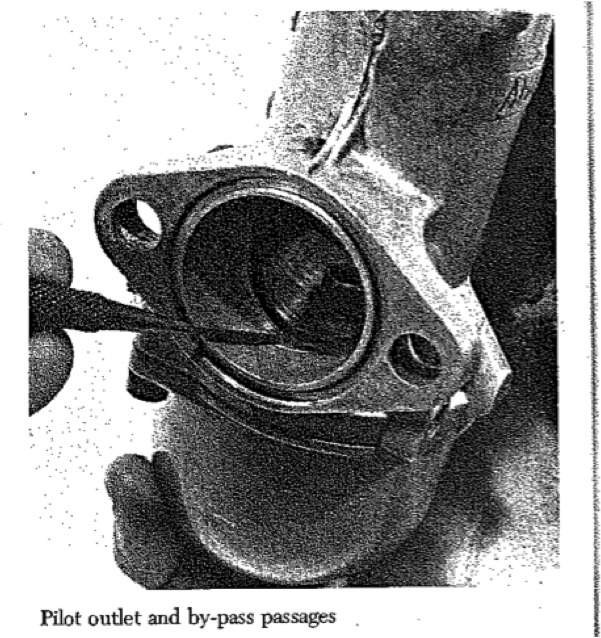General Form and Function of the Carburetor

Carburetor
General Form and Function of the Carburetor
The Carburetor:
The purpose of a carburetor is to effectively mix air and gasoline to achieve the correct mixture to allow the motorcycle to run efficiently. In it’s most basic form, the carburetor is an open pipe through which air and fuel pass into the engine. The main parts of a carburetor are the body, the throttle and the pilot outlet.
Components of a Carburetor:
The Body
- The body is one-piece and typically is made out of cheap pot metal
- One component of the body is the venturi.

- A venturi is a condensed portion of a pipe.
- Discovered by Giovanni Venturi, the Venturi Effect is the decreased pressure experienced when passing through a smaller portion of a pipe.
- In the carburetor, this means that it contains a section in the pipe where the diameter decreases.
- As a result, the speed of the vapor increases and its pressure will decrease in this smaller portion of the pipe.
- The lower pressure in the venturi will attract fuel from the fuel bowl into the pipe in an attempt to even out of the lower vapor pressure of the venturi and the higher atmospheric pressure in the fuel bowl.
- The relationship between the pressure, density and velocity in a venturi:
- (P1 – P2) = density / 2 * (V2^2 – V1^2)

- The body also contains holes for the throttle slide, fuel and air as well as spots for the fuel and air jets.
- Primary air passage
- Mixes the gasoline with air before hitting the venturi
- Pilot air passage
- Air from this passage used for idle and low-sped operation
- Primary air passage
- The body has a place for the float bowl.
- Contains the fuel and a float valve
- The float valve is a mechanism which controls the fuel released by alternately pressing its needle against the seat and releasing it.
- By doing so, it controls the amount of fuel that escapes and makes sure the ratio of fuel to air will be precise.
- Contains the fuel and a float valve
The Throttle Slide
- Connected to the throttle on the twist grip via the throttle cable.
- When activated, opens and closes the throttle plate various amounts depending on the amount the throttle grip is twisted.
- Sets the size of the venturi by opening/closing a certain amount and, as a result, controls the amount of air/fuel that will travel to the engine.
- Contains the jet needle
- Controls the amount of gasoline that will enter the fuel/air mixture and travel to the engine
- The throttle slide is important because it paces the power of the engine and thereby the speed of the bike.
The Pilot Outlet

- The part of the carburetor through which the fuel/air mixture will travel to the engine.
- When an engine is cold, it requires a different fuel-to-air ratio in order to start the vehicle. To do so there must be more fuel in the mixture than usual. The reasoning behind this alteration in the fuel-to-air ratio is that the engine will be easier to ignite with more fuel (easier to light a spark).
- The Choke Valve is in charge of filtering the air into the carburetor, before the venturi. By restricting the air that enters the carburetor, more fuel will be able to enter the mixture and thereby increase the fuel in the fuel-to-air ratio.
- Pressure is created in the carburetor by the piston. The piston strokes up and down, creating a vacuum that will send the fuel/air mixture through the carburetor and into the engine.
- The atmospheric pressure of the carburetor generally will be 15 pounds per square inch: 15 PSI.
- In theory, the carburetor will lower/greaten the atmospheric pressure inside of it so that its pressure will no longer be equal to the atmospheric pressure outside the engine. By doing so, the carburetor will cause air to either rush into the carburetor or slow down its entry tremendously until the pressures are equalized.
Operation of the Carburetor:

- Starting Circuit (0 Throttle Opening)
- Engine needs a rich mixture (more fuel) to start the bike when its cold
- The Starting Circuit limits the amount of air that enters the mixture so it will be fuel-heavy
- This is done by closing the mouth that allows air to enter the carburetor with a plate (see choke) or by overflowing the float bowl
- Overflowing the float bowl will activate the ticklers
- The ticklers are a device of the float bowl that will depress the float when the bowl is overflowing and allow the fuel to flow through the jets and create a rich mixture
- Purpose of the Starting Circuit is to start or warm up the engine.
- Idle Circuit (0 – 1/8 Throttle Opening)
- Idle requires very little fuel and air
- Idle means that the engine is on but the car is not moving and rider is not pushing on the gas
- Consists of a pilot jet, pilot air passage and throttle slide
- For this circuit, the air/fuel mixture is very important because the engine is turning very slowly
- Pilot Screw adjusts the mixture to maintain a good idle
- The Pilot Screw is a tapered needle that controls the amount of fuel/air that enters the carb by blocking the passage
- The Pilot Screw is a tapered needle that controls the amount of fuel/air that enters the carb by blocking the passage
- Pilot Screw adjusts the mixture to maintain a good idle
- Idle requires very little fuel and air

- Low Speed Circuit (1/8 – 1/4 Throttle Opening)
- Consists of a pilot jet, pilot air passage and the throttle slide
- The airflow will increase as a result of the opening of the throttle slide while the amount of fuel simultaneously increases as the needle comes out of the needle jet.
- Midrange Circuit (1/4 – 3/4 Throttle Opening)
- Air will be supplied by the ventrui and the primary air passage.
- Fuel is given by the float bowl and the amount is controlled by the needle jet.
- High-Speed Circuit (3/4 – Full Throttle)
- The throttle slide is opened completely while the needle is removed from the needle jet. The amount of air/fuel that enters the carburetor is no longer controlled by these devices.
- This state of operation is paced completely by the venturi size and the amount of fuel that comes from the main jet.
- Each of these states overlaps a bit with the others so that the transition from one to the next will be smooth.

Our Involvement with the Carburetor
The carburetor started out in good shape so there was not much repairing that needed to be done. For this reason, the main work that we did with the carburetor was cleaning the outside as well as removing it and then later putting it back on the motorcycle. Although we did not do much reparation for the carburetor, we still were able to learn a lot about its form and function, especially the way that it contributes to the smooth ride.